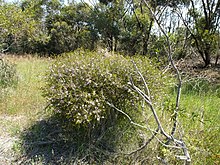|
Melaleuca camptoclada
Melaleuca camptoclada is a shrub in the myrtle family, Myrtaceae and is endemic to the south-west of Western Australia. It was first described in 1990 in a review of the genus Melaleuca when the species Melaleuca laxiflora at that time was found to comprise ten species. Two of those species were new - M. camptoclada and M. ctenoides.[2] DescriptionMelaleuca camptoclada is a shrub growing to a height of about 3 m (10 ft). Its leaves and branches are glabrous or almost so. The leaves are 2.9–5.5 mm (0.1–0.2 in) long and 1.5–1.8 mm (0.06–0.07 in) wide and elliptical in shape.[3] The flowers are mauve and are arranged in heads or spikes to 16 mm (0.6 in) in diameter, with 5 to 15 individual flowers. The petals are 1.5–2.4 mm (0.06–0.09 in) long and fall off as the flowers open. The stamens are arranged in five bundles around the flower with 9 to 16 stamens in each bundle. Flowering occurs from September to November and the fruit are woody capsules, 2.5–3.5 mm (0.098–0.14 in) long.[3]   Taxonomy and namingMelaleuca camptoclada was first formally described in 1990 by F.C.Quinn from a specimen found near the Stirling Ranges.[4] The specific epithet (camptoclada) is from the Greek camptos, (flexible or curved) and clados (a shoot or branch), referring to the habit of this species.[3] Distribution and habitatThis melaleuca occurs in the Esperance Plains, Jarrah Forest and Warren biogeographic regions.[5] It grows in gravelly sand and clay loam.[6] Conservation statusMelaleuca camptoclada is listed as "not threatened" by the Government of Western Australia Department of Parks and Wildlife.[5] References
|
||||||||||||||||||||||||||||
